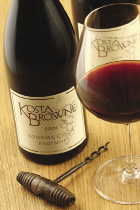- Home
- Media Kit
- Current Issue
- Past Issues
- Ad Specs-Submission
- Ad Print Settings
- Reprints (PDF)
- Photo Specifications (PDF)
- Contact Us

![]()
ONLINE

Value-Driven
Editors’ Note
Dan Kosta began his fine-dining career working for John Ash & Co. restaurant in Santa Rosa, California, and eventually became the restaurant’s Operations Manager and Wine Director. Kosta has also consulted for restaurants in California’s Sonoma County and sits on the boards of directors for the Sonoma County Harvest Fair and the Sonoma County Tourism Bureau, as well as participates as a judge for the San Francisco Chronicle Wine Competition, West Coast Wine Competition, and Grand Harvest Awards.
Company Brief
Founded in 1997 by Dan Kosta and Michael Browne, Sebastopol, California-based Kosta Browne Winery (www.kostabrowne.com) produces single vineyard pinot noirs under three appellations – Sonoma Coast, Russian River Valley, and Santa Lucia Highlands.
How has the current economic climate affected the business for Kosta Browne Winery?
Everyone in the wine industry has been affected in some way. Luckily for us, we’re only seeing a few people not order their full allocations. But our allocation sizes are so small that most people are taking their full allocation. If people can’t afford their full allocation or any part of their allocation, we won’t kick them off the list for that, even though we have thousands of people waiting for the wines. In addition, we came into these economic times with what we think are very reasonably value-driven prices. Our wines are between $52 a bottle and $72 a bottle compared to Bordeaux or Napa Valley cabernet, which can get upwards of $500 to $750 a bottle. Those guys with that pricing are probably feeling the pinch a little more than we are.

Kosta Browne
2004 Pinot Noir
Is production volume remaining relatively consistent, or has there been a change?
We’ve been at 10,000 cases since ’06. Although 2009 is still on the vine, we’ll probably see a little increase. But quality is directly related to quantity when it comes to pinot noir. We like our small lots and the vineyards that we have right now can only give us so many grapes.
How do allocations differ from client to client, and are there clear methods to how you allocate?
We used to assemble our customers into allocation groups, and that was limited to a handful of five or six groups, which was limited by our software – there is not a ton of great software out there for these allocation models. But as we move forward, we’re working closely with our software company to individualize allocations, so that each customer can establish his own purchase history and his allocation is created from that. At the same time, that person can request more via a wish list, and if we are able to grant that, we add it on to their purchase history as well.
You’ve released ’07. With regard to timing, where are you in the process?
We released the ’07 Russian River and Sonoma Coast on May 1st. On October 1st, we release our single vineyard wines.
Do you know what type of vintage the single vineyard wine will be yet?
We do, because we bottle all of the ’07s in January, including the blends and single vineyard wines. Those have been in bottles for about six months, so we know the quality of the finished product, and ’07 produced some of the best wines that we’ve ever made. These single vineyards that have been in bottles for six months are really starting to open up and we are seeing the complexity of the ’07s. We still recommend when people get those in November to hold onto them for another six months or so, at least to let them lose their baby fat and open up a little bit.
In founding this company with Michael Browne in 1997, did you know that your interest areas and levels of expertise would complement each other well?
I think so; that part hasn’t changed. Michael and I made our first vintage together in 1997, and after that, we realized that we needed to specialize in what our strengths were. Michael’s strength was more on the winemaking side, and I knew lots of people across the country having been a wine director before. We do complement each other because I’ll get in the cellar and help out, especially during blending time, and Michael will go out on the road and do wine dinners as well. But I’d be remiss if I didn’t mention our third partner Chris Costello, who manages the business, the accounting, and our direct-to-consumer systems – that’s his strength, and those are skills that Michael and I didn’t have. So when we brought Chris on as a partner in 2001, the trilogy was complete.
In the early days, did you know it would work, and are you surprised at how much of an impact the brand has had?
We did envision ourselves being where we are today, but in retrospect, it was a little naïve. We knew where we wanted to be, and to expect that was a lofty goal, but it helped that our standard was set and that was the goal, and we all had our eyes on it. We just powered through and didn’t take no for an answer, but there were two or three times when it was really tough and we thought we were probably not going to make it, but we didn’t give up. There were a lot of influential people that came before us that may or may not have had success, but really should have because their wine-making was so dramatic and groundbreaking. Those are the guys that blazed the trail for us, so we’re just happy to be a part of that wine-making history in California.
Do you foresee an opportunity to broaden into categories other than pinot noir, or will this remain the core and the key focus?
It’s always going to remain the core and the key focus. We did a little rosé and syrah from Amber Ridge – just a couple hundred cases, for fun – but we’re 100 percent pinot noir now. However, we are going to make about 200 cases of chardonnay this year from the Bondi Ranch in the Russian River Valley.
Is it the same procedure and expertise whatever you’re making, or are there different things you need to know?
Michael Browne has worked for other wineries and made chardonnay with Deerfield Ranch Winery, so he’s experienced in that. It’s a new path that we’re going down so we have to determine the style of the chardonnay that we want. I don’t think it will necessarily follow the same path as the pinot noir, but it will be a prettier chardonnay that is a useful piece in our portfolio. We still want to achieve complexity and intensity while maintaining the grape’s elegant side, the same standards we set for our pinot noir production.